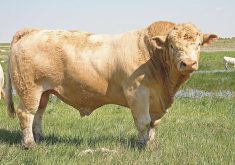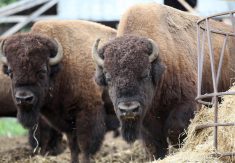Bad year 2012 was just one of those years when Mother Nature gave a free pass to aster yellows, but the rise in blackleg was man made
Hope for a cold winter to knock back aster yellows, loosen up your canola rotations to avoid blackleg, and pick your pulse cultivars with disease resistance in mind.
Those were three key pieces of advice offered by Alberta Agriculture pathologist Michael Harding at the recent Alberta Pulse Growers meeting.
Aster yellows have been stealing yield on the Canadian Prairies since the 1950s but in Alberta, you don’t generally find more than a five per cent infestation in a canola field, said Harding.
“That usually doesn’t lead to any significant economic penalty,” he said. “In 2012, however, there were fields that had 10, 20 or even 30 per cent symptoms of aster yellows.”
Read Also

Roundup retraction makes public trust ripples
A foundational study on glyphosate safety was recently retracted, while Roundup maker Bayer has already said it may ditch the key agricultural herbicide after lawsuits piled up.
The disease is caused by a bacteria-like organism called a phytoplasma and attacks a wide range of cereals, oilseeds and vegetables. But it doesn’t overwinter and is spread by the aster leafhopper, which spends its winters south of the border.
“The determining factor for aster yellows in Alberta is the leafhopper migration,” said Harder.
Last year’s mild winter set the stage for this summer’s perfect storm — the leafhoppers survived much farther north than usual and then not-so-favourable winds blew them into Alberta early. More than 12 per cent of the critters were carrying the disease — four to 12 times that normal rate.
“For one reason or another, a huge number of aster leafhoppers were infected when they arrived,” said Harding. “They arrived early, so there was lots of opportunity for the disease to spread and to spread widely.”
Hopefully, that won’t happen two years in a row, but if it does, there’s not a lot a farmer can do.
Mowing down grass — leafhoppers’ preferred food — helps, but there’s no spray for aster yellows. You can spray for leafhoppers, but once isn’t enough.
“Once you throw the insecticide on, you will create some other things to deal with, as you will disrupt the natural population of insects that are just hanging out or are potentially beneficial,” Harding said. “You will create population booms of various insects, including the leafhopper, because they don’t stop coming with one migration. If you spray once, you’d better be prepared to spray two to three times.”
Even knowing infestation levels is tough. Aster yellows in canola can be spotted because plants stick up a little higher than the rest of the canopy, and exhibit bladder-like pods and discolouration. The symptoms will generally start at the top of the plant, where the insects feed, unlike many soil- and residue-borne diseases which start at the bottom. But since other viral diseases cause similar symptoms, you need a molecular test to know for sure, Harding said.
Simple but tough solution
It’s a different story with blackleg. It’s not only easy to spot, the solution is simple — don’t grow canola too often.
“If you don’t have canola stubble, blackleg isn’t going to be there,” Harding said. “If you have canola stubble, you’re probably going to have some blackleg.”
Alberta is home to both the virulent and avirulent strains of blackleg, and there was a real jump in virulent cases across the Prairies this year. And — no surprise — this was especially true when farmers planted canola on canola.
“This disease can accumulate very rapidly in a tight rotation because it’s got the double threat or the one-two punch. It can produce millions of spores creating a rapid buildup of inoculum in a season.”
Blackleg doesn’t survive well in soil, but since it takes three years for canola stubble to fully break down, that is why a four-year rotation is recommended. There are resistant varieties but the organism has a talent for mutating and so planting those varieties in infected fields just hastens the day when the resistance is gone.
Foliar fungicides are effective, but once again, they don’t fix the underlying problem, said Harding.
“In some cases, fungicide application doesn’t decrease the incidence, it just decreases the severity,” he said. “You save yourself the yield penalty, but still have all that inoculum present for the next time you’re cropping.”
Tillage may help
For those determined to take their chances, Harding recommends rotating herbicide management systems and breaking out the plow.
“If blackleg is the biggest problem on your farm, bury the residue,” he said. “This flies in the face of conservation tillage but if that stubble is underground, it will break down much faster than it will if it is just under the surface.”
Tight rotations are not only a gamble for your farm, but also for the Canadian canola industry’s market in China, he added.
“China doesn’t want the virulent strain, which they don’t say they don’t have, which is why there’s additional concern,” said Harding.
Turning to pulses, the pathologist urged attendees to pick varieties resistant to seedling diseases and then see which ones work best.
“If you’ve noticed that one particular cultivar does well on your farm, even when it’s wet, then that’s a good choice,” he said.
Signs of seedling blights and seed decay include poor emergence, or plants that die soon after emergence. Cool soil temperatures and wet soils make it easier for seedling blights to develop.
Root rot caused fusarium, rhizoctonia and pythium can attack the seed, roots and seedling below the ground.
“If you pull up a plant and the roots are black or brown or the roots are pinched off, that’s a sign that you’ve got root rot,” said Harding.
Avoid planting pulse crops in poorly drained fields or compacted ones, and consider using fungicidal seed treatment.
“It’s cost effective. You might not need the seed treatment every year, but most years, you’ll be really glad you have it on there,” he said.
Fungicidal seed treatments available for pulse crops are also effective against soil-aborne fungi and will provide protection against seed rot and seedling blight.















